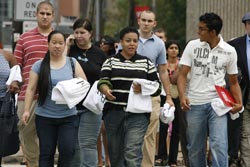|
"Temple is a more attractive choice than ever for high school students and their families," said Timm Rinehart, associate vice president for Enrollment Management. "Temple's reputation is spreading, and when visitors come to campus, they like what they see."
Like many of her classmates, Allison Kim, a freshman from Hatboro, Pa., in the College of Liberal Arts, was sold almost as soon as she set foot on campus.
“I had visited a couple of colleges and was having a lot of trouble deciding, but after I visited Temple, it was a done deal,” said Kim, who chose Temple over Villanova and Bryn Mawr. “I liked the look of the campus — it felt safe, with a lot of security — and there seemed to be a lot of activities and events going on. It wasn’t difficult to choose.”
For most of Temple’s newest students, one of the university’s top draws is its urban location, with all the associated benefits.
"I knew I wanted to go to school in a big city, and I love Philadelphia," said Mitchell Bloom, a freshman in the College of Liberal Arts from Hollidaysburg, a small town in west-central Pennsylvania.
"There are endless possibilities of things to do here," said Bloom, who also was admitted to the College of Charleston in South Carolina. "You can't find a better place to look for internships, and I'm excited about Temple’s diversity. When I visited other schools, everyone looked like me."
Sonali Shah, a freshman in the College of Science and Technology from Massena in northern New York state, chose Temple over 12 other colleges, including Cornell University.
"Temple's location was the best," said Shah, who is enrolled in Temple MedScholars, an eight-year program offering provisional admission to Temple's School of Medicine after graduation. "Culture-wise, Philadelphia offers so much."
This year, Temple's popularity translated into an unusually high percentage of accepted students choosing to attend Temple, or what admissions administrators call "yield." According to the Office of Enrollment Management, Temple's yield increased from 37 percent in 2006-07 to approximately 41 percent in this year's admissions cycle — by far the largest increase in a decade.
Timm Rinehart lauds Temple's new electronic admissions system for helping to streamline the admissions process.
"This was the first year the admissions office went paperless," Rinehart said. "About 85 percent of our applications were submitted online this year, compared to less than 50 percent last year. It enables us to make decisions more quickly and efficiently so we can provide better and more timely service to students and their families."
According to recent projections, about 53 percent of this year's freshmen and transfers are from Philadelphia and the four surrounding Pennsylvania counties, 16 percent are from parts of Pennsylvania outside Greater Philadelphia, 25 percent are U.S. residents from out of state and 5 percent are from abroad.
Almost one-third of incoming freshmen identified themselves as students of color (about another 6 percent identified their ethnicity as "other").
For the second year in a row, Temple has experienced a dramatic increase in the number of freshmen who are “legacies,” or students who have at least one parent with a Temple degree. The number of children of Temple graduates in the freshman class has more than doubled in a two-year span, jumping from 190 in fall 2005 to 302 in 2006, and then to approximately 450 in 2007.
“Sending a child to one’s alma mater may be the most powerful endorsement that an alumnus or alumna can make,” said Temple President Ann Weaver Hart. “The unprecedented surge in legacies in Temple’s recent freshman classes affirms what our alumni tell me when I travel across the country: They like what they have heard about Temple’s energy, and they share our optimism about where the university is going — so much so that they want their children to be part of that shared future.”
|
